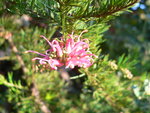Bonsaidoorguy
Chumono
I was at a local nursery this last weekend and in with the discounted plants I saw this little guy marked as a Grevillea "Canberra Gem". I was unfamiliar with it but it said evergreen and almost looked like a fir. So for eight bucks I grabbed it and took it home. I did a little looking on YouTube and on this site and could find very little. I think it's native to Australia? I'm curious if anyone is familiar with this plant? I want to know how hard I can cut it back and get back budding. The base has a nice start but I'm unsure where to go with it, suggestions? Thanks in advance.





